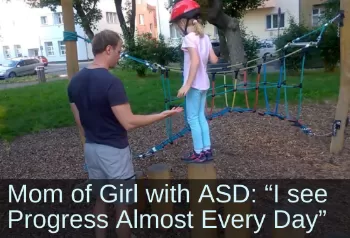Primitive Reflex Integration Case Studies
Improvements in Speech, Motor, Vision, Social-Emotional — After One Year, “a Completely Different Child”
Girl with ASD benefits from rhythmic movements and reflex integration
This 6-year-old exhibited substantial speech and motor delays, poor emotional regulation, and attention challenges. After receiving neurodevelopmental movements and reflex integration from the Brain and Sensory Foundations course, she showed improvements in all areas, and was able to start attending school.
Submitted by L.B., parent

| Before | After |
|---|---|
| Mostly nonverbal, using a few words | Functional conversation still not present, however much improved understanding, able to sing songs, say poems, spontaneously name objects, colors etc.; improved pronunciation |
| Poor gross motor skills, tended to swing for unlimited time | Gross motor skills much improved; rides bike without pedals very well, swings normally, can hop on one foot |
| Very poor fine motor skills | Has started drawing, building with blocks, working with jigsaw puzzles |
| Visual problems, poor focus | Very interested in pictures, details, letters; able to read 50 words |
I started to work with R, a 6-year-old girl with ASD, using movement therapy when she was 5-years-old. At that time she was seldom present with lot of tantrums. It was quite difficult to make contact with her.
She loved to eat cashew nuts so at the beginning I used them as motivation to help her organize her body. We started in supine position I offered her nuts on left and right side of her body, asking her to use right or left hand to pick it. We did many variations, working with the midline of her body.
As she progressed, we moved to complicated prone positions, I asked her to move with her head from side to side, lifting her chest and limbs. Each session lasted only few minutes.
Later we incorporated a variety of developmental movements [from the Brain and Sensory Foundations course]. Often we work together with other siblings (her younger and older sister), it was strong motivation for her to see other kids do the same, also more funny. We also started with rhythmic movements, [from the Brain and Sensory Foundations course] which she liked very much. She learned quickly how to keep the rhythm and she was able to do rhythmic movements herself, each for one minute. She was also able to do cross crawl very well, also cross clapping.
We also worked with hands and toes. I offered her my old electric piano which she loved. Within a short time period she was able to use all 10 fingers independently.
Later we did isometrics for ATNR [Asymmetrical Tonic Neck Reflex] integration [from the Brain and Sensory Foundations course]. This time again I used cashew nuts as motivation to keep her in the right position for sufficient time. We have practiced these isometrics for one month. One day we were on the playground and she herself wanted to try new attractions requiring balance like walking on the rope bridge! I was very surprised.
This movement program lasted 5 months. She changed very much: being much more present, interested in world around. Her gross and fine motor skills improved rapidly. She was able to start attending nursery school, which brought new perspectives into her life. And she could start with other therapies which was not able before (now she is involved in NACD program). She continues progressing. After one year she is completely different child. Still her language skills are limited, but she is using new words spontaneously. Her social skills are much better—she is able to cooperate with siblings and other kids. The number of tantrums decreased significantly, usually she is nice and calm. Her cognition is much better. Now she is interested in letters and she is even able to read 50 words. She has still many challenges but as I see progress almost every day, I believe she will overcome each of them.
[Edited for length and clarity, emphasis added]
*Disclaimer: The activities in the Brain and Sensory Foundations curriculum make use of the natural processes of neuroplasticity and development that are innately wired in the design of human beings to promote maturity and function. These activities appear to calm, organize, and mature the neuro-sensory-motor systems just as we see in the healthy development of human infants. Individual results may vary, and we do not claim to offer a diagnosis or cure for any specific condition or disorder. The Brain and Sensory Foundations activities appear to improve overall functioning resulting in measurable improvements for a range of conditions as demonstrated in over 1800 case studies from participants.

